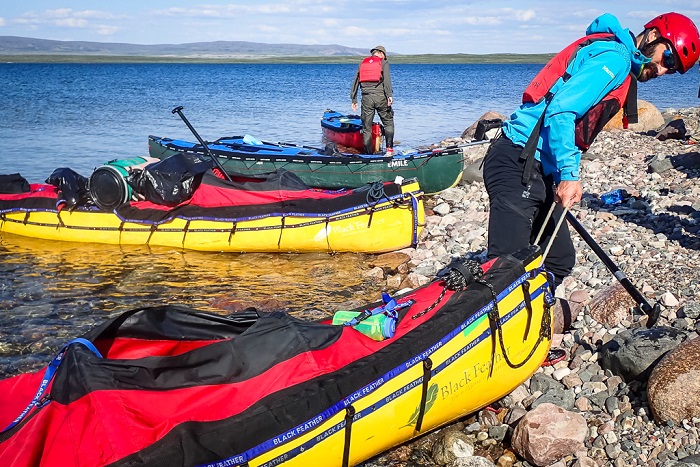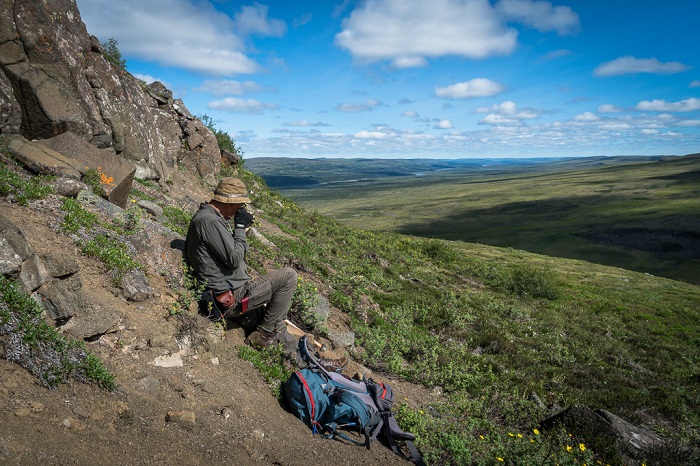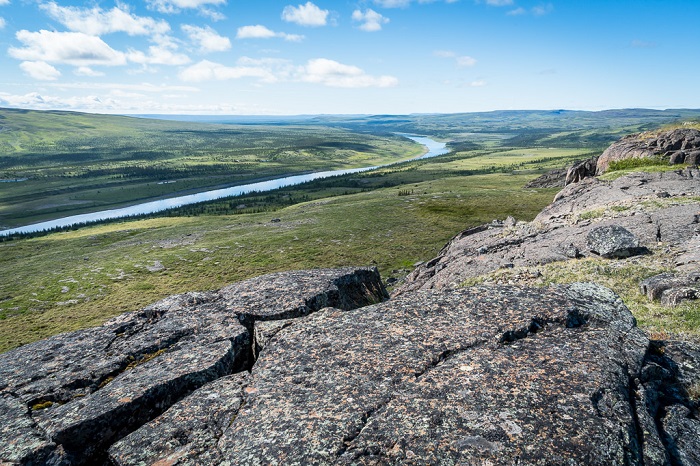Text and photos by Vivien Cumming – @drvivcumming
What happens when you fly 12 people into a field camp in a plane and then have to get them and all their food and belongings into six canoes? You send stuff back in the plane!
We didn’t send too much back though. I’m amazed what you can fit in six canoes: 12 people, 24 big barrels, six small barrels, two bags full of tents, a fire box, a gas stove, two wannigans (kitchen boxes), two pelican cases containing drones, computers and cameras, and last but not least, a guitar.
Most of our barrels are filled with food, and we have been eating well. We’ve been cooking over fires in the firebox so as not to leave a trace at our campsites. Roast beef, freshly caught fish, eggs and bacon for breakfast, and my personal favourite — fire-baked cinnamon buns!
Usually fieldwork done by the Geological Survey of Canada (GSC) in remote parts of the North is executed by helicopter, but there is something about using human muscle and the power of water to get to where you want to go. As we get more proficient at reading the river, we start to see that at times it requires no effort, just ability to see how the water will move you. Always limited by where the river takes you, it brings an understanding of the lives of early explorers.

Hauling a loaded canoe up the beach to set up camp - Vivien Cumming.
We are following the route of George Douglas and August Sandberg, who explored this region in 1911–12 in search of the source of copper nuggets that could be found in the riverbed — hence the name Coppermine River.
The first part of our journey takes us east through the three Dismal Lakes to the Kendall River, which then joins the Coppermine River. Douglas got through the lakes in two days describing them as getting less and less dismal the further east you go.
It took us three days to get down the lakes, and we had very similar weather conditions to Douglas, our first day being the most challenging. As we packed up the canoes, the wind picked up and showed no sign of dying, so we had to paddle head on into the wind to get across the lake. Hard going for our first day in the canoes, fully loaded with food and gear.
The second lake gave us the opposite experience. The wind was behind us so we rafted up and used a tarp as a sail and paddles duck-taped together as a mast (it’s amazing what you can do with duct tape) and whistled on down the lake.
The third lake again was not so friendly. The morning we woke up to do this lake, the wind was strong and producing waves side on to our direction of travel, not safe in fully loaded canoes, so we waited it out all day and ended up leaving at 9 p.m. when the wind had died. Arctic summer nights make this easy as the sun only goes down for an instant and it never gets dark. We arrived at 2 a.m. — a beautiful sunset paddle with a view on the way of a mother grizzly and her three cubs playing on the shore.

Surveying rapids on the Kendall River - Vivien Cumming.
The Kendall River then posed the next challenge — our first go at rapids in fully loaded canoes. We all made it through; one canoe ended up going backwards down the rapids, but nothing too dramatic to contend with. As we reached the end of the river, the vastness of the Coppermine River came into view — wide and mighty — suddenly we experienced what its like to paddle in fast-flowing current. You don’t need to paddle that much really!
Each time we arrive at camp, the first priority is getting some kind of shelter up. In our modern world of cities, we take for granted what a roof over our heads means for us. In the wilderness, you know only too well how important shelter is. It can be the difference between life and death, and up here the weather changes in a heartbeat, from hot sunny days to freezing wind and rain at any moment. Second priority — food of course!

Tom Skulski checking out lava flow samples with his hand lens - Vivien Cumming.
During this part of the trip, we are sampling lava flows from a huge volcanic event, called the Mackenzie event, which overlies the life-bearing sedimentary rocks we were studying at Dismal Lakes. Tom Skulski from the GSC is leading us up into endless layers of lava making up the mountains all around us. I call them the burnt pancake mountains (they are actually called the September Mountains), because the layers of dark basaltic lava look like a stack of pancakes.
The scale of these volcanic eruptions is huge — similar to the Columbia River flood basalts. Evidence from the ancient eruptions here can be found over 2,000 km away in southern Canada. A previous study, published in 1996 by Baragar and colleagues, found about 150 flows with a total thickness of 3 km, and we are trying to sample them all!

Mountains made up of lava flows on top of each other - burnt pancakes - Vivien Cumming.
Eruptions of this scale have a huge impact on the Earth’s climate system and life. We don’t yet know what this eruption was caused by, maybe a meteorite impact or a hot spot in the Earth’s mantle, like what’s below Hawaii today.
Events of this magnitude are similar to the huge extinction events like the one that wiped out the dinosaurs. We are here to find out what this event did to life at the time and how long these eruptions lasted. “That’s one of the reasons we are here — we don’t know,” says Rob Rainbird, of the GSC, who is leading the trip.
We are looking at the rocks before, during and after this event — to get a sense of how the planet reacted to such a major outpouring of magma. We can certainly see it all around us now. Making up this stunning landscape.

The Coppermine River snakes through a stunning landscape made up of volcanic rocks at the edge of the tree line - Vivien Cumming.
The landscape here reminds me of parts of my home country of Scotland, rolling hills and patchy trees, but here our efforts have been rewarded with sightings of caribou, muskoxen, grizzly bears, bald eagles, moose, wolves and the little sparrow-like bird we rescued from drowning in the river.
As the water kindly moves us further down the Coppermine River, we will come across the rocks that overlie the pancake lava flows and complete our story of this strange time period over a billion years ago.
